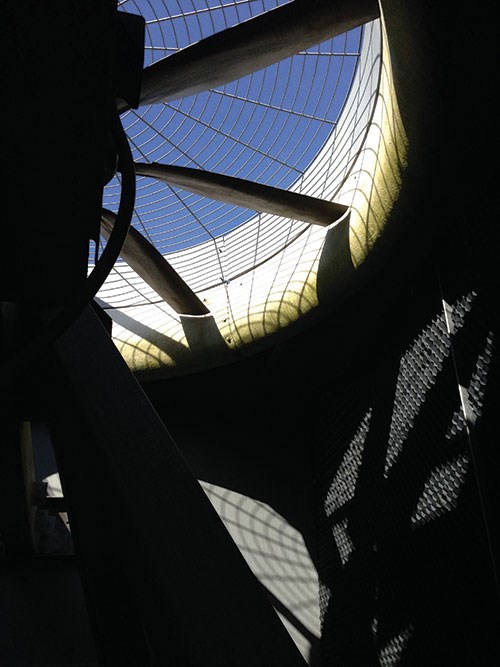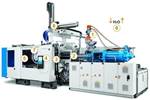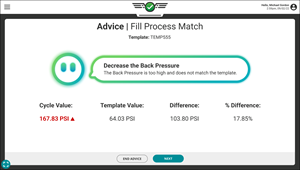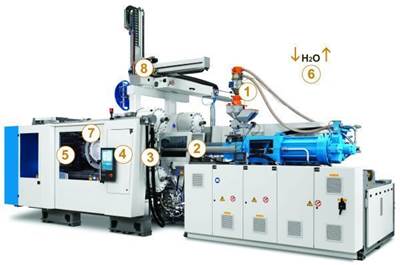Designing a Better Heat Exchanger - Part 3
In part three of our three-part sub-series on mold water cooling systems, we review the impact a water system can have on mold performance and part quality.
Say you receive a call from a frustrated molder explaining that the mold you just delivered is having flash issues. You immediately pick up your mold, get it back to your plant and break the mold down to find out the reason for the flash. You find nothing out of place. You complete preventive maintenance and return the mold to the molder for a second sample. It yields similar results. What did you miss?
Say you repeat this process a few times with the same results, as costs mount and time slips away. In the end, you discover that the thermolator was not working properly or the open-air water system wasn’t performing because of a recent heat wave or because a massive
amount of organic matter was blocking the water lines.
Once the plant’s water system is identified as the culprit, you use a local chiller unit to isolate the system’s water from the overall plant. This yields an accurate temperature for the process, and the flash issues go away. When you ask who will cover the accrued costs for identifying and correcting the problem, the molder replies, “We’ll make it up to you on the next one.” However, the “next one” never comes.
To prevent this situation from happening, arm yourself with the following information:
Plant water system’s primary job. The first job of the plant’s water system is to provide clean water at a consistent temperature and constant flow rate to yield an efficient molding process. Invest in a good set of flow meters and a contact-style pyrometer to check and document mold steel temperatures and thermolator/chiller hose-fitting temperatures.
Water system’s strengths and weaknesses. A closed-loop water system is designed to supply hot or chilled water to an external heat exchanger and then return it to the point of origin to repeat the process. This system protects the water from outside contamination, which can affect its ability to maintain consistent temperature. It is common to use a plant chilling system to maintain a uniform water temperature of lower than 100°F. An open recirculating cooling system uses the same water repeatedly to cool the equipment. The heat absorbed from the process is dissipated via cooling towers, spray ponds or evaporative condensers to allow the water’s reuse. This system exposes the water to outside contaminants such as dirt, leaves and insects, and its performance can be greatly influenced by weather conditions as well.
When it comes to plant water systems, don’t forget to consider loss of water. If you must chemically treat the plant’s water supply, make sure to monitor the water quality, otherwise the chemical composition may degrade the water’s composition and quality, which can lead to inconsistent water performance over time. The two most common culprits of water loss are evaporation, which is common in open recirculating cooling systems, and spillage, which results from water left in the mold as it is moved in and out of the press. Also, some plants purge water into buckets as opposed to back into the water system, using bypass valves at the press.
Water system components’ impact on mold performance. Temperature control units, known as thermolators, are typically local to the molding machine and used for applications that require mold steel temperatures of 100°F or higher. The goal of a temperature control unit is to sustain a unifom temperature while not creating any negative impact on the molding process. If a temperature control unit is not delivering the water at the expected temperature or flow rate, mold performance can be compromised. Always verify that the thermolator is operating properly.
Local chiller units also impact mold performance. Typically, these units are located next to the molding machine and are used only on the mold half that has the most standing cavity shape onto which the part shrinks. Too large of a thermal difference between the A and B halves can result in premature leader-pin and bushing wear. It also can negatively impact vent performance and galling shutoffs. Chillers are used for applications requiring mold steel temperatures of 100°F or lower.
Quick couplings for water lines are another component that can restrict water flow and pressure loss through the mold. It is important to avoid 90-degree fittings whenever possible and not to sacrifice performance for the overall clean look of the mold. Find a better way to manage water lines. When using a quick coupling to a water manifold system, ensure that the allowable volume does not restrict the individual lines leaving the water manifold.
To design and build a plastic injection mold’s water system, the mold builder must understand the molder’s water system, water quality and auxiliary equipment. Treat each mold as a unique heat exchanger whose water system needs your attention to the details.
Related Content
AI Augments Injection Molding Process Control System
MAX, a new process advising feature added to RJG’s Copilot system, is engineered to help troubleshoot and optimize the injection molding process and addresses industry skill gap.
Read MoreMMT Chats: 5 in 5 with Neu Dynamics
MoldMaking Technology editorial director Christina Fuges chats with Kevin Hartsoe, president of Neu Dynamics to reveal their five best practices for improving efficiencies in culture, technology, process, measuring success and staying competitive ... in 5 minutes.
Read MoreCube Mold Technology Advancing Injection Molding
Injection mold design features a central rotating cube that can split and counter-rotate, with additional gear elements on the exterior.
Read MoreMMT Chats: Molds, Molding, Marketing and Membership
MoldMaking Technology Editorial Director Christina Fuges chats with Eric Hecker, Sales and Project Engineer for Eifel about his focus on sales and marketing, the move into molding, technology and training trends and his mission to help increase membership in Mold Technologies Division of SPE. This episode is brought to you by ISCAR with New Ideas for Machining Intelligently.
Read MoreRead Next
Designing a Better Heat Exchanger - Part 2
In part two of our three-part sub-series on mold water cooling systems, we review water quality and its impact on mold performance.
Read MoreDesigning a Better Heat Exchanger - Part 1
In a three-part sub-series, we review considerations for mold water cooling systems.
Read MoreHow to Use Strategic Planning Tools, Data to Manage the Human Side of Business
Q&A with Marion Wells, MMT EAB member and founder of Human Asset Management.
Read More
























